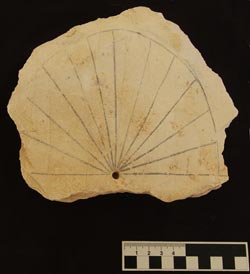One of the world’s oldest sun dial dug up in Kings’ Valley

Significant find: After thousands of years the Egyptian sun dial was brought back to light.<br>Image: Unversity of Basel<br>
The team of the Egyptological Seminar under the direction of Prof. Susanne Bickel made the significant discovery while clearing the entrance to one of the tombs.
During this year’s excavations the researchers found a flattened piece of limestone (so-called Ostracon) on which a semicircle in black color had been drawn. The semicircle is divided into twelve sections of about 15 degrees each.
A dent in the middle of the approximately 16 centimeter long horizontal baseline served to insert a wooden or metal bolt that would cast a shadow to show the hours of the day. Small dots in the middle of each section were used for even more detailed time measuring.
The sun dial was found in an area of stone huts that were used in the 13th century BC to house the men working at the construction of the graves. The sun dial was possibly used to measure their work hours. However, the division of the sun path into hours also played a crucial role in the so-called netherworld guides that were drawn onto the walls of the royal tombs.
These guides are illustrated texts that chronologically describe the nightly progression of the sun-god through the underworld. Thus, the sun dial could also have served to further visualize this phenomenon.
During this year’s excavation in cooperation with the Egyptian authorities and with the help of students of the University of Basel over 500 mostly fragmentary objects that had been recovered in former seasons were documented and prepared for further scientific examination. This also includes all the material of the lower strata of tomb KV 64 found in 2012. Inside the roughly 3500 year old tomb Basel researchers had discovered a sarcophagus that was holding the mummy of a woman named Nehemes-Bastet.
Further Inquiries
Prof. Dr. Susanne Bickel, Departement Altertumswissenschaften der Universität Basel, Tel. +41 61 267 30 61, E-Mail: s.bickel@unibas.ch
Media Contact
All latest news from the category: Earth Sciences
Earth Sciences (also referred to as Geosciences), which deals with basic issues surrounding our planet, plays a vital role in the area of energy and raw materials supply.
Earth Sciences comprises subjects such as geology, geography, geological informatics, paleontology, mineralogy, petrography, crystallography, geophysics, geodesy, glaciology, cartography, photogrammetry, meteorology and seismology, early-warning systems, earthquake research and polar research.
Newest articles

Silicon Carbide Innovation Alliance to drive industrial-scale semiconductor work
Known for its ability to withstand extreme environments and high voltages, silicon carbide (SiC) is a semiconducting material made up of silicon and carbon atoms arranged into crystals that is…

New SPECT/CT technique shows impressive biomarker identification
…offers increased access for prostate cancer patients. A novel SPECT/CT acquisition method can accurately detect radiopharmaceutical biodistribution in a convenient manner for prostate cancer patients, opening the door for more…

How 3D printers can give robots a soft touch
Soft skin coverings and touch sensors have emerged as a promising feature for robots that are both safer and more intuitive for human interaction, but they are expensive and difficult…




















